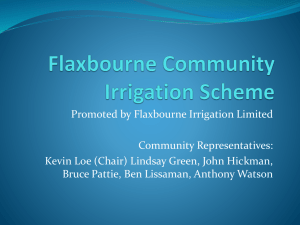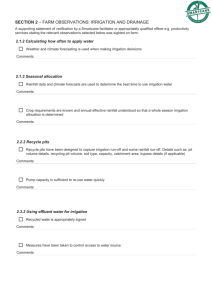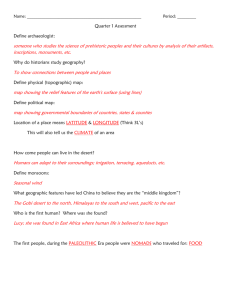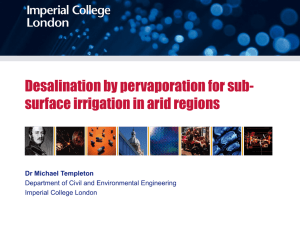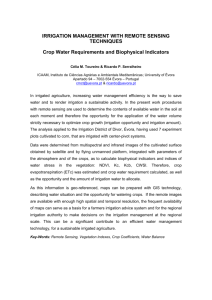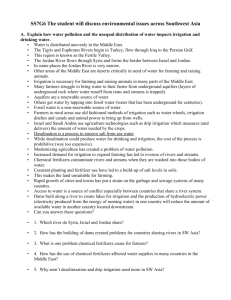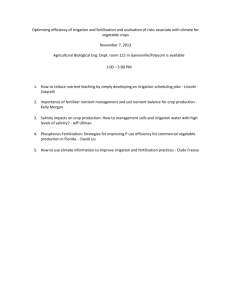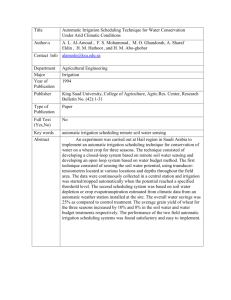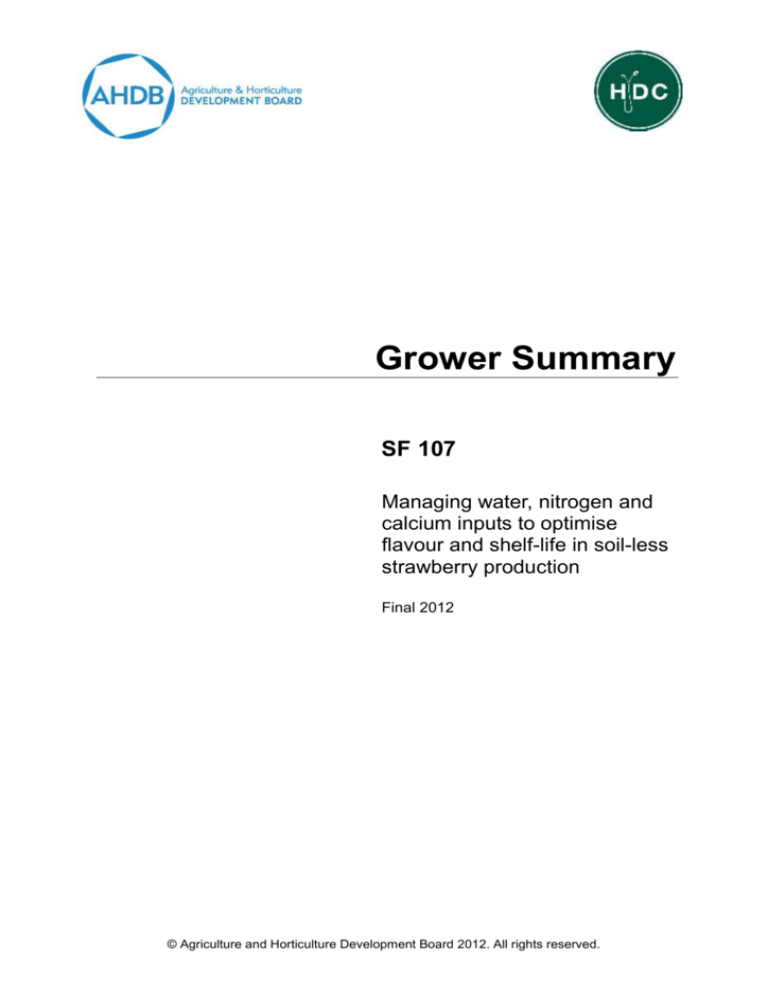
Grower Summary
SF 107
Managing water, nitrogen and
calcium inputs to optimise
flavour and shelf-life in soil-less
strawberry production
Final 2012
© Agriculture and Horticulture Development Board 2012. All rights reserved.
Disclaimer
AHDB, operating through its HDC division seeks to ensure that the information contained
within this document is accurate at the time of printing. No warranty is given in respect
thereof and, to the maximum extent permitted by law the Agriculture and Horticulture
Development Board accepts no liability for loss, damage or injury howsoever caused
(including that caused by negligence) or suffered directly or indirectly in relation to
information and opinions contained in or omitted from this document.
No part of this publication may be reproduced in any material form (including by photocopy or
storage in any medium by electronic means) or any copy or adaptation stored, published or
distributed (by physical, electronic or other means) without the prior permission in writing of
the Agriculture and Horticulture Development Board, other than by reproduction in an
unmodified form for the sole purpose of use as an information resource when the Agriculture
and Horticulture Development Board or HDC is clearly acknowledged as the source, or in
accordance with the provisions of the Copyright, Designs and Patents Act 1988. All rights
reserved.
AHDB (logo) is a registered trademark of the Agriculture and Horticulture Development
Board. HDC is a registered trademark of the Agriculture and Horticulture Development
Board, for use by its HDC division. All other trademarks, logos and brand names contained in
this publication are the trademarks of their respective holders. No rights are granted without
the prior written permission of the relevant owners.
The results and conclusions in this report may be based on an investigation conducted over
one year. Therefore, care must be taken with the interpretation of the results.
Use of pesticides
Only officially approved pesticides may be used in the UK. Approvals are normally granted
only in relation to individual products and for specified uses. It is an offence to use nonapproved products or to use approved products in a manner that does not comply with the
statutory conditions of use, except where the crop or situation is the subject of an off-label
extension of use.
Before using all pesticides check the approval status and conditions of use.
Read the label before use: use pesticides safely.
Further information
If you would like a copy of the full report, please email the HDC office
(hdc@hdc.ahdb.org.uk), quoting your HDC number, alternatively contact the HDC at the
address below.
HDC
Stoneleigh Park
Kenilworth
Warwickshire
CV8 2TL
Tel – 0247 669 2051
HDC is a division of the Agriculture and Horticulture Development Board.
© Agriculture and Horticulture Development Board 2012. All rights reserved.
Project Number:
SF 107
Project Title:
Managing water, nitrogen and calcium inputs to optimise
flavour and shelf-life in soil-less strawberry production.
Project Leader:
Dr Mark A Else
Contractor:
East Malling Research
Industry Representative:
Mr John Atwood, ADAS
Report:
Final Report 2012
Publication Date:
14/08/2012
Previous report/(s):
Annual Report 2010
Start Date:
01 April 2009
End Date:
31 March 2012
Project Cost (Total Project Cost):
£90,959 (£173,778)
© Agriculture and Horticulture Development Board 2012. All rights reserved.
Headline
In substrate grown strawberries, water savings of between 15% and 45% were delivered
using a new irrigation scheduling strategy without reducing Class 1 yields.
Background and expected deliverables
The project aims to provide the potential to increase water use efficiency and nutrient use
efficiency in UK substrate-grown strawberry production by 40% thereby saving water,
reducing the impact of soft fruit production on groundwater quality and improving fruit quality
and shelf-life.
Irrigation of substrate-grown strawberries is essential to ensure the yields and quality
demanded by retailers and consumers. Many growers apply sufficient irrigation to achieve
10-20% run-off to avoid dry spots within the substrate bags and to reduce the accumulation
of salts.
However, Defra, the Environment Agency (EA) and the soft fruit industry are
becoming increasingly concerned about the future availability of abstracted water for trickle
irrigation.
Current abstraction rates in the major strawberry-growing regions are
unsustainable and growers must now comply with legislation designed to safeguard these
resources (The Water Act 2003).
Figure GS1. Reducing inputs of valuable resources such as water and fertilisers must be
achieved without reducing yields and quality of Class 1 fruit
At the time of writing (May 2012), the south east is officially under drought and other major
soft fruit growing regions were at high risk of drought in 2012 (Figure GS2) until aboveaverage rainfall in April alleviated the problem in some production areas.
© Agriculture and Horticulture Development Board 2012. All rights reserved.
Figure GS2. Assessment of drought risk across England and Wales for 2012. Source: the
Environment Agency.
Nevertheless, ‘blue water’ availability will become increasingly limited, especially in the
summer months and mains water will be more expensive; the use of mains water to irrigate
horticultural crops is likely to be restricted in heavily populated areas as pressure on finite
supplies intensifies. There is also increasing concern over the contribution of substrate soft
fruit production to ground water pollution, and the EA recently commissioned ADAS to carry
out a study to determine the impact of substrate production on ground water quality in the
south east. Clearly, new soft fruit production systems are needed that use resources such as
water and fertilsers more efficienctly. Recent research at EMR and elsewhere has provided
major opportunities to improve water and nutrient use efficiencies while continuing to deliver
high yields of fruit that meet consumer demand for sweet berries with good flavour and shelflife.
Improved irrigation scheduling techniques and deficit irrigation techniques such as Regulated
Deficit Irrigation (RDI) offer the potential to deliver large water savings while maintaining or
improving crop quality. The aim of irrigation scheduling is to match demand with supply
during changeable weather conditions. Deficit irrigation techniques such as RDI replace only
a percentage of the water the plant loses via transpiration. This saves water and can prevent
excessive shoot growth without reducing yields of Class 1 fruit. The smaller, less dense
canopy can reduce disease pressure and helps to improve light capture by the plant because
there is less self-shading of the leaves. Better light penetration and interception will also help
to increase fruit quality including flavour volatile production and bioactive content.
© Agriculture and Horticulture Development Board 2012. All rights reserved.
The
reduction in vegetative growth also provides opportunities to reduce fertiliser inputs without
affecting berry flavour. For growers using mains water, there is the potential to reduce
annual water costs by up to 40% and significant reductions in fertiliser inputs are also likely.
There are two aims to this project:
1. To improve water and nutrient use efficiencies in substrate-grown strawberry
production
2. To improve flavour and shelf-life potential by manipulating nitrogen and calcium
nutrition
Expected deliverables from this work will include:
Improved fruit firmness, flavour and shelf-life potential
Reduced production costs per tonne Class 1 fruit
Reduced water and fertiliser usage by up to 40%
Reduced environmental impact
Improved sustainability
Summary of the project and main conclusions
Developing an irrigation scheduling technique that matches demand with
supply
In the first two years of the project, an irrigation scheduling technique that matches demand
with supply and so minimises or eliminates run-off was developed using irrigation set points
based on volumetric substrate moisture contents (VSMC). The irrigation scheduling regime
was imposed on 60-day and mainseason ‘Elsanta’ and ‘Sonata’ plants grown in 0.5-m peat
bags (Figure GS3). Irrigation was supplied to Commercial Control plants to achieve an
average run-off of 20% over the season.
In 2009 with 60-day crops, water and fertiliser
savings of up to 45% were achieved, compared to the Commercial Control treatment, without
reducing yields of Class 1 fruit. Overall, marketable yields were low due to the effect of the
x10 strength potassium bicarbonate spray applied in error.
Despite the reduced nutrient input under the irrigation scheduling regime, foliar
concentrations of N, P, K, Mg, Mn, Fe, Zn, B and S were within satisfactory ranges in each
cultivar under each irrigation regime although concentrations of Ca and Cu were just below
satisfactory values by the end of the cropping season.
© Agriculture and Horticulture Development Board 2012. All rights reserved.
Figure GS3. The main season ‘Elsanta’ plants used in the 2010 experiments to determine
the effects of irrigation scheduling and RDI on water and nutrient use efficiencies and fruit
quality. Photo taken on 9 May 2010.
In 2010, although run-off was eliminated and water and fertiliser savings of 50% were
achieved using the irrigation scheduling technique, main season ‘Elsanta’ and ‘Sonata’ Class
1 yields were reduced by 27% and by 13%, respectively, compared to the Commercial
Control regime.
This was due to a reduction in fruit size rather than fruit number and
presumably resulted from temporary limitations in substrate water availability under high
evaporative demands. Therefore, the lower VSMC irrigation set points were raised for the
2011 irrigation scheduling experiments (see below).
In 2011, scheduling irrigation to match demand with supply so that run-off was minimised or
eliminated resulted in water savings of up to 42% and 45% for ‘Elsanta’ and ‘Sonata’,
respectively, compared to the Commercial Control treatments where run-off averaged 20%
over the season (Table GS1).
Table GS1. Total volumes of irrigation water applied per plant (L) for 60-day ‘Elsanta’ and
‘Sonata’ under the irrigation and NO3-N:NH4-N regimes and the associated percent run-off
averaged over the season.
Treatment
CC
Scheduled
20% NH4-N
30% NH4-N
Volume of water applied (L)
‘Elsanta’
‘Sonata’
31.2
42.7
26.5
24.3
22.3
33.4
18.0
23.6
Average run off (%)
‘Elsanta’
‘Sonata’
22.4
19.3
4.4
0.0
5.6
0.2
0.2
4.6
Water productivity (WP) values were also calculated for each irrigation regime and for each
cultivar (Table GS2). The volume of water applied was first recorded from Day 0 (27 July
2011) and so the WP values do not include water that was used to wet up the substrate
bags, water that was applied via overhead irrigation during establishment or the water that
© Agriculture and Horticulture Development Board 2012. All rights reserved.
was applied during the first three weeks of plant development before the irrigation regimes
were imposed.
Nevertheless, the WP values indicate the potential of using irrigation
scheduling to reduce the volume of water used to produce 1 kg of Class 1 fruit. Typical
grower WP values are not yet known for substrate-grown strawberries but will be calculated
from data gathered at two grower sites during 2012 in SF 136.
Table GS2. Water productivity values associated with irrigation and NO3-N:NH4-N regimes
for 60-day ‘Elsanta’ and ‘Sonata’.
Cultivar
‘Elsanta’
‘Sonata’
CC
48.6
78.4
Water productivity (L per kg class 1 fruit)
Scheduled
20% NH4-N
30% NH4-N
38.0
42.6
36.3
49.4
69.2
51.3
Since plants were fertigated at each irrigation event, the total amounts of the macro and
micro nutrients applied to each bag were reduced in proportion to the irrigation volume.
Consequently, fertiliser savings of between 15% and 45% were achieved using the irrigation
scheduling regimes to reduce or eliminate run-off.
Despite these reduced inputs, leaf
nutrient concentrations remained within satisfactory ranges in ‘Elsanta’ throughout cropping.
However, Ca concentrations were reduced in leaves of ‘Sonata’ by the end of cropping
although fruit firmness and shelf-life potential was not affected.
The new approach to irrigation scheduling developed in SF 107 has potential to further
improve the economic and environmental sustainability of substrate soft fruit production in
the UK. Managing the volume of run-off throughout fruit development under changeable
evaporative demands in crops of different ages is challenging for commercial growers.
Manually collecting and measuring run-off volumes in each block of substrate crop in time to
inform irrigation decisions can be time consuming and an automated system that enabled
irrigators to react quickly to differing evaporative demands would help to deliver significant
water and fertiliser savings. The system developed in this project enables data on water
inputs and outputs to be accessed remotely (Figure GS4) so that the percent run-off after
each irrigation event can be calculated.
© Agriculture and Horticulture Development Board 2012. All rights reserved.
Figure GS4. Rain gauges and data loggers with telemetry are being used to record water
input and output volumes in grower trials in SF 136.
This information can then be used to highlight times of the day when run-off is excessive and
the duration of these events can then be adjusted to reduce water and fertiliser losses.
Continuous monitoring of VSMC also ensures that water availability does not become limiting
once run-off has been reduced. The potential build-up of salts can also be monitored using
EC probes and managed by flushing through with acidified water or dilute calcium nitrate
solutions if needed.
During these experiments, equipment from several different
manufacturers has been used to develop an automated irrigation system that enables
precise control of run-off. For commercial exploitation, these systems need to be integrated
into a single controller unit. We are currently identifying the necessary components of this
system in Project SF 136.
Testing the potential of RDI regimes to deliver water savings and improved fruit
quality
Previous Defra-funded work at EMR had shown that an RDI regime that replaced only 80%
of the water lost by evapotranspiration could deliver significant water savings and improved
aspects of fruit quality in substrate-grown strawberry. These strategic experiments were
carried out on main season crops in 6 L containers and it was important to test the
effectiveness of RDI using commercial planting densities where the available substrate
volume per plant is considerably less.
RDI was imposed on 60-day and main season
‘Elsanta’ and ‘Sonata’ plants in 2009 and 2010, respectively, grown in 0.5-m bags of peat. In
2009, an 80% RDI regime reduced total leaf areas by 20% and 39% in ‘Elsanta’ and
‘Sonata’, respectively (Figure GS5), and the percentage of ‘Sonata’ fruit that developed
bruising over a 6-day shelf-life test was reduced from 45% in Commercial Controls to 15% by
RDI. However, although Class 1 yields were similar to those obtained from Commercial
Control plants, substrate EC was increased by 20% under the RDI regime by the end of the
growing season.
© Agriculture and Horticulture Development Board 2012. All rights reserved.
Lamina area (cm2)
1600
Run-off
ETp 100%
RDI 80%
1200
800
400
0
14/07/09
21/07/09
28/07/09
05/08/09
01/10/09
Date of measurement
Figure GS5. Effect of the irrigation regimes on estimated total canopy area of ‘Sonata’
In 2010, RDI regimes were imposed on mainseason ‘Elsanta’ and ‘Sonata’ plants and
physiological responses to substrate drying such as lowered stomatal conductances,
transpiration rates, leaf growth and photosynthetic rates were detected. Total canopy areas
were reduced by up to 58% and 62% in RDI-treated ‘Elsanta’ and ‘Sonata’, respectively.
However, Class 1 yields were also significantly reduced in RDI-treated plants compared to
Commercial Control values (449 g vs 231 g). Although we have shown in strategic
experiments that RDI has the potential to deliver significant water and fertiliser savings in
substrates, as well as improvements in fruit quality, the technique would be difficult to
implement in commercial substrate strawberry production. Maintaining the substrate within
the target upper and lower VSMC set points under high evaporative demand would be
challenging due to the limited substrate volumes (3-4 L per plant) and growing in coir would
further increase the risk of shoot water deficits and associated reductions in Class 1 yields
and quality. However, we have shown in SF 83 that RDI can be used very successfully in
soil-grown crops to deliver water savings and improved fruit quality.
Manipulating N nutrition
The aim of this work was to test the potential to manipulate ammonium-N (N-NH4) and
nitrate-N (N-NO3) ratios to try to improve berry firmness and shelf-life potential, particularly in
cultivars such as ’Sonata’ where berries can be soft and vulnerable to bruising. In our
experiment, changing the percentage of ammonium-N from 10% to either 20% or 30% did
not significantly affect plant physiology or fruit quality. No consistent effects of altering NO 3N: NH4-N ratios on foliar nutrient concentrations were detected and so it was not necessary
to increase Ca concentrations in the fertiliser feed mixes. In the 60-day crop in 2011, the
different NO3-N:NH4-N regimes were applied for only six weeks but during that time, no
significant treatment differences were observed. In previous work, higher ratios of NO 3-
© Agriculture and Horticulture Development Board 2012. All rights reserved.
N:NH4-N have been needed to elicit physiological responses (e.g. 50%:50%, 25%:75%) but
during the preparation of the original proposal, industry representatives felt that ratios greater
than 70%:30% would limit fruit yields and quality. Work in other cropping systems has shown
that a 70%:30% NO3-N:NH4-N ratio did not affect physiology under normal conditions but
helped to improve tolerance to high salinity stress via altered plant hormone signalling. More
work is needed to determine the potential of manipulating N nutrition in this way to improve
not only aspects of fruit quality and flavour, but also tolerance to high salinities and the buildup of ‘ballast’ ions (e.g. Na+, Cl-) in substrates.
It should be noted that throughout this project, Class 1 yields have been lower than
anticipated due to issues associated with powdery mildew.
However, the approaches
developed in SF 107 have also been trialled in other Defra-funded work at EMR with
mainseason substrate-grown ‘Elsanta’ crops and significant savings in water and fertilisers
have been achieved whilst maintaining good commercial yields of high quality fruit.
Main Conclusions
Irrigation scheduling and deficit irrigation regimes were imposed on 60-day and main
season ‘Elsanta’ and ‘Sonata’ plants.
A new irrigation scheduling strategy has been developed for substrate-grown strawberries
that reduces or eliminates run-off. In this strategy, irrigation inputs and outputs are
monitored continuously using rain gauges and data loggers with telemetry. This
information is used to adjust the timing and frequency of irrigation so that run-off is
eliminated and demand is matched with supply. VSMC and EC are also measured
continuously to ensure that irrigation is scheduled effectively and substrate EC levels
are controlled adequately once run-off has been eliminated.
Water savings of between 15% and 45% were delivered without reducing Class 1 yields
using the new irrigation scheduling strategy. Since nutrients were added at each
irrigation event, fertiliser savings of up to 45% have also been achieved
The lower fertiliser inputs under the irrigation scheduling regime resulted in reduced leaf
concentrations of Ca in ‘Sonata’ but fruit quality was not affected.
An RDI regime was developed that limited excessive canopy growth and improved berry
shelf-life potential in 60-day crops. However, Class 1 yields were reduced by 17% in
the mainseason crops, due to temporary losses of shoot turgor at high evaporative
demands when substrate water availability was limited.
RDI would be difficult to implement in some commercial substrate production systems
where the accuracy and consistency of water delivery may not be sufficient to
maintain VSMCs between upper and lower set points. Under these circumstances,
© Agriculture and Horticulture Development Board 2012. All rights reserved.
the risk of shoot water deficits and associated reductions in Class 1 yields and quality
would be high.
An automated system has been developed that triggers irrigation automatically once the
VSMC has fallen to a pre-determined lower set point. By adjusting the frequency and
duration of irrigation events, the volume of run-off can be fine-tuned during different
stages of crop development. The system is currently being tested in commercial
grower trials in SF 136.
Altering the contribution of NH4-N from 10% to either 20% or 30% did not alter plant
physiology or aspects of fruit quality in either ‘Elsanta’ or ‘Sonata’. Further strategic
work is needed to identify the NO3-N:NH4-N ratio that affects plant physiology and
fruit quality attributes. The potential of altering N nutrition to improve tolerance to
salinity stress in substrate soft fruit production should also be investigated.
Fertiliser savings of between £448 and £2,025 per ha per annum could be achieved by
scheduling irrigation so that run-off was minimised or eliminated.
New fertigation regimes need to be developed to optimise plant nutrition under watersaving irrigation strategies.
Financial benefits
The project aims to improve the economic sustainability of soil-less strawberry production by
improving both water and nutrient use efficiencies. In our experiments, water and nutrients
were delivered to the substrate around each plant by using four dripper stakes per 0.5-m bag
to ensure an even distribution, to prevent dry spots from developing and minimise the
likelihood of run-off. However, in commercial production with 1-m bags, costs associated
with doubling the number of dripper spikes to eight per bag may be prohibitive. These extra
costs must be set against the water and fertiliser savings (see below) to decide whether this
approach would be financially viable. The approach being used in both commercial trials in
SF 136 is to use five 1.2 L per hour drippers per 1-m substrate bag. Some growers are
beginning to switch to this system instead of using a 6 L per hour dripper with four irrigation
spikes per 1-m bag since water would still be supplied to the majority of the substrate should
individual drippers become blocked; these could then be readily and inexpensively replaced.
Clearly, the economics of this approach are feasible for commercial production systems.
The reduction in fertiliser use of between 15% and 45% could be expected to deliver
significant cost savings to growers. The Rural Business Research (RBR) 2008/2009 Farm
Business Survey for Horticulture Production in England reported average annual fertiliser
costs (across all specialist glass businesses including soft fruit) of £3,250-£4,500/ha. On this
basis, a 15% reduction in fertiliser used could, on average, save £488-£675/ha while a 45 %
© Agriculture and Horticulture Development Board 2012. All rights reserved.
reduction in fertiliser used could save £1,464-£2,025/ha. The RBR 2008/2009 survey
reported average annual water costs (across all specialist glass businesses including soft
fruit) of £530-£630. This confirms that, generally speaking, the savings in expenditure on
water do not justify expenditure on irrigation scheduling tools. Growers using mains water
would expect to pay significantly more for water and there may then be a significant financial
benefit to using less water. However, the reduction in energy use through pumping less
water could be significant. If a grower could save at least £600/ha in fertiliser from the use of
an irrigation scheduling tool, then a cost of at least £300/ha/annum for that scheduling tool
would seem reasonable. A more complete cost benefit analysis will be carried out using data
from the grower trials at New Farm Produce Ltd and S.H. Chesson Partnership and included
in the 2013 Final Report for SF 136.
Action points for growers
Employ an irrigation consultant to ensure that current and new irrigation systems are
designed correctly to achieve accurate and precise delivery of water and fertilisers.
Monitor run-off at different times throughout the day to establish which irrigation
events can be reduced to save water and fertilisers.
Consider using vapour pressure deficits (VPD) to help inform irrigation decisions.
Use substrate moisture and EC probes to help inform irrigation decisions.
Current industry ‘standard’, ‘best’ and ‘better’ practice must be first be established
before the water and nutrient use efficiencies delivered in this project can be
assessed in a commercial context. It would be helpful if substrate strawberry growers
would fill out and return a questionnaire on water and fertiliser use efficiencies.
Please contact Scott Raffle or Andrew Tinsley at HDC for a copy of the questionnaire.
© Agriculture and Horticulture Development Board 2012. All rights reserved.

